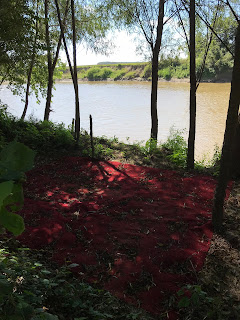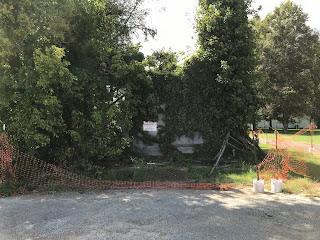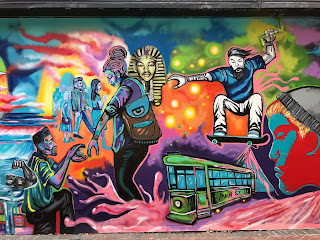Tallahatchie and Leflore Counties, Mississippi
Sunday, September 2, 2018
Please go back and read my comments towards the end of the post on Little Rock...about the statement made by a woman on the tour of Little Rock Central High School. I'll add some comments later but for now I'm going to let these images speak for themselves:
If you want more context for the photos above, here is a article from 2018 with comments from Patrick Weems. I spent most of Sunday afternoon talking with him at the Emmett Till Interpretive Center in Sumner, MS. where he serves as co-founder. More recently, new bullet proof signs have been installed at the site.
If you've done any study of the civil rights struggle, you know that lynchings, intimidation and other forms of terrorism against black citizens existed before Emmett Till's death. For example - from 1877 to 1950, the state of Florida had more lynchings per capita than any other state. In addition, Orange county had more lynchings than any other county in Florida.
So what was I doing in Mississippi? The story of Emmett Till takes place in the communities of Money and Greenwood (Leflore County), Glendora and Sumner (Tallahatchie County) and Sunflower County, Mississippi. Many historians call the lynching of Emmett Till on August 28, 1955, the start of the U.S. Civil Rights movement. It is why the March on Washington for Jobs and Freedom took place on August 28, 1963. I had to go there to pay my respects and to be educated in this history.
I first went to the site where Emmett Till's body was found - on the banks of the Tallahatchie River in Glendora, MS. I admit I was a bit uncomfortable going to this area. A few friends told me not to go to Mississippi because of the still existing racism and suspicion of outsiders. In addition, the location where Till's broken body was found is in the middle of vast cotton fields where there is little to no help if anything happens. As you might have noticed from the date above, I decided to go on a Sunday morning. I assumed people would be in church and/or on their best behavior. Being in this isolated location gave me a small sense of how easy it must have been to terrorize a population in those times.
I walked down to the river's edge and found a red blanket laid out on the ground. I asked Patrick Weems about this but he was just as perplexed about its existence and meaning. I thought it may have been evidence of a homeless camp or possibly someone's kind attempt to mark the area where Till's body was placed after being pulled up from the river but in reality, I don't know the answer.
I next stopped at the Emmett Till Historical Intrepid Center (ETHIC) just to see it. I knew it wasn't open on this day but still needed to make a stop at as many locations related to his story as I could.
Next I visited the Sumner Courthouse where the "trial" of J.W. Milam and Roy Bryant resulted in the two being acquitted by an all white, all male jury. Women were not allowed to serve on jury duty at that time according to the southern norms. Patrick told me the jury was made up of poor whites who had no education and distorted, concrete-solid racist attitudes - all the more reason to take out their frustrations on anyone from the black population - a 14 year old child in this case. The two men later confessed to the murder of Till but because of double jeopardy, couldn't be tried for the same crime twice. Carolyn Bryant, the original accuser of Till, later recanted her accusation. In the video below, Patrick provides a brief description of why the court room was renovated and then returned to its original design:
The apology mentioned by Patrick happened in 2007.
The Till historic marker is on the right side of the courthouse
A monument to Southern heroes of the Civil War is on the left side of the courthouse
Quick note - For the last few years, several celebrities have been working on producing films, tv series, etc. on the Emmett Till story.
Patrick told me a story about a local man who one day showed up at the Sumner County courthouse, site of the trial against the two men charged with Till's murder. The man started shouting racial slurs, threatening violence and complaining that he did not want to hear anything more about "this history". Remember, there is a civil war monument on the courthouse grounds. His intentions to use his truck to tear out the newly installed historical marker in front of the courthouse were obvious.
The local sheriff called a member of the Center, Carolyn Webb, for help. She was able to get this man to slow down and think about Emmett by appealing to the fact that this man also had a 14-year-old son. He paused and drove away. A little while later, the man showed up to Carolyn's house and said he and his wife wanted to donate the cloth for the unveiling of the historical marker planned for the next day. This man even said he would protect the marker from any harm from now on. He slowed down, made a connection between his son and the humanity of Emmett Till, and changed his actions. He cared about people but the circle was not inclusive. Carolyn offered a pathway for change and he took it.
My last stop was at the site of Bryant's Grocery & Meat Market - the place where this terrible story begins. What's left of the building is now overgrown with plants and barely standing. According to the Emmett Till Interpretive Center, the crumbling building and site is now owned by the descendants of Ray Tribble, one of the jurors in the 1955 trial. Critics say the site is being "held hostage" by the family for a sales price of 4 million dollars.
I'll end this post with what is, in my opinion, the most pivotal moment next to Till's murder. Moses "Mose" Wright, Till's Great Uncle, was called by the prosecution as a witness. He courageously stood up and pointed to the murderers. Look for the U.S. Flag on the left. The chair below it was approximately where Wright would have stood. Brian (with the black hat), Jesse (the teenager in the middle) and Patrick (man on right) are the people in the picture. Brian and and his step-grandson Jesse were on the tour with me. Patrick was giving us the tour and is seated in the same place as the defendants. You can see how close Wright would have been to Milam and Bryant in this incredibly intense moment. Wright risked everything to point out the murderers. He later left Mississippi, never to return again.
Brian, the man wearing the black hat in the photo above, had this statement on his shirt:
Make Racism Wrong Again
UPDATE: There are efforts underway to turn the sites related to Emmett Till into a National Park.























